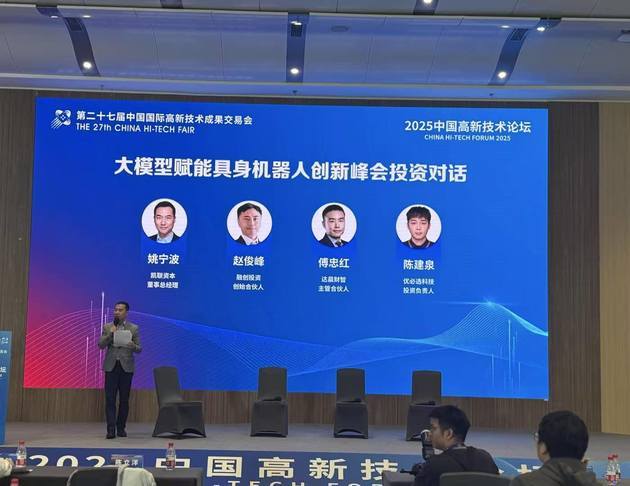On November 14, the 27th China Hi-Tech Fair (hereinafter "the Fair") opened at the Shenzhen World Exhibition & Convention Center. With the theme "Technology Empowers Industry, Integration Creates the Future," this year's Fair brought together more than 5,000 leading companies and international organizations from over 100 countries and regions, showcasing more than 5,000 cutting-edge technological innovations.
At the exhibition, humanoid robots powered by embodied intelligence became a major highlight. Nearly every robotics company featured live demonstrations of humanoid machines on site.
As one of the core forums of the Fair, the "Large Model Empowered Embodied Robotics Innovation Summit – Investment Dialogue" (hereinafter "the Summit") attracted guests from Capitallink, RC Investments, Fortune Venture Capital, UBTECH Robotics, among others. Speakers engaged in in-depth discussions on controversies surrounding potential financing bubbles, industry landscape, commercialization pathways, and early-stage innovation directions—offering valuable insights for both industry development and investment decisions.

Industry Debates Investment Opportunities in Embodied Intelligence
The rapid rise of humanoid robot demonstrations at the Fair has fueled debate over whether the financing boom in embodied intelligence signals overheating or genuine opportunity. Some believe the market is overheating, with bubbles forming and the competitive landscape largely set—especially in core technologies. However, most Summit participants argued this view is overly simplistic, stressing that meaningful opportunities remain.
Fu Zhonghong, Managing Partner at Fortune Venture Capital, said the competitive landscape is far from settled, with new business models emerging daily and players from adjacent sectors entering the field. "Most companies in the industry are still small, and their applications are concentrated in lifestyle training, education, and other limited scenarios. They are still far from the real battleground, meaning startups continue to have vast room for growth."
Zhao Junfeng, Founding Partner of RC Investments, noted that the industry currently has more than 100 related enterprises, yet truly profitable application scenarios and distribution channels are scarce. Drawing on his 20-plus years of investment experience, Zhao emphasized that the core challenge for embodied intelligence lies in soaring costs—including development, validation, large-scale testing, and marketing—making profitability difficult for most companies. As a financial investor, Runxuan is adopting a more cautious approach, prioritizing investments in equipment, materials, foundational algorithms, and other enabling technologies.

Humanoid robot shot at the Fair (Photo by NBD reporter Zhen Sujing)
"We focus on import-substitution opportunities—such as reducers, motor control systems, control chips, and key circuit boards. These components have high technical barriers and stable demand, making them more certain investment targets at this stage," Zhao said. Despite strong prospects for AI, he noted that only a handful of companies in the sector have achieved profitability or gone public, urging investors to remain rational.
Yao Ningbo, Managing Director at Capitallink, argued that technological progress is creating new opportunities, though challenges in cost and implementation remain. Drawing from his experience at Intel a decade ago working on early smart-robotics projects, Yao noted that the industry failed to take off at the time due to limitations in AI technology. Today, with rapid iterations in large models and perception technologies, investment enthusiasm has surged.
From the perspective of an industry practitioner, Chen Jianquan, Head of Investor Relations at UBTECH Robotics, offered a different angle. As an early participant in humanoid robotics, UBTECH received multiple rounds of capital support from the angel stage to its IPO, and is now investing across the industry value chain. For early-stage companies, Chen said the maturity of their technical architecture is the key evaluation metric, while for more advanced firms, engineering execution and commercialization capabilities become critical.
Technology Routes Converge as Industry Approaches a Key "Remote-Controller-Free" Turning Point

Humanoid robot shot at the Fair (Photo by NBD reporter Zhen Sujing)
When discussing technological trends in embodied intelligence, all speakers agreed that achieving "remote-controller-free" operation marks a crucial milestone. Yet practical implementation and scenario expansion remain central challenges.
Fu noted that industry technology routes have become increasingly similar, and the sector is now approaching a pivotal inflection point. He expects companies to release remote-controller-free robots as early as next year. However, battery life remains a bottleneck: "To achieve true autonomous operation, robots must overcome endurance limitations. Whoever makes the breakthrough first will take the lead."
From an observer's perspective, Yao highlighted the importance of edge computing. By shifting computation from cloud to edge, issues of latency and bandwidth can be reduced—critical for autonomous decision-making. "Real embodied intelligence is not a remotely operated machine; it requires long-term integration of technology, data, and real-world scenarios."
Chen, speaking from practical deployment experience, offered a more cautious view on achieving general-purpose intelligence. He noted that AI models and hardware systems are still far from supporting broad scenario generalization. In UBTECH's unmanned logistics solutions, 90% of tasks are automated, but the remaining 10% still require human intervention—precisely where humanoid robots could step in. Both wheeled and bipedal robots can be tested in these transitional scenarios, though wheeled systems remain more limited by terrain and application scope.
Regarding timelines, Chen estimated that in industrial settings, once deployments reach 500–1,000 units, accumulated real-world data could trigger a breakthrough in model generalization. However, achieving general-purpose capabilities across complex sectors such as automotive manufacturing could take around a decade due to exponentially increasing data demands.
"For commercialization, robots must serve as data-collection carriers, autonomously navigating and generating high-quality datasets for training. Video or synthetic data alone cannot support real industrial deployment," Chen said.


 川公网安备 51019002001991号
川公网安备 51019002001991号





